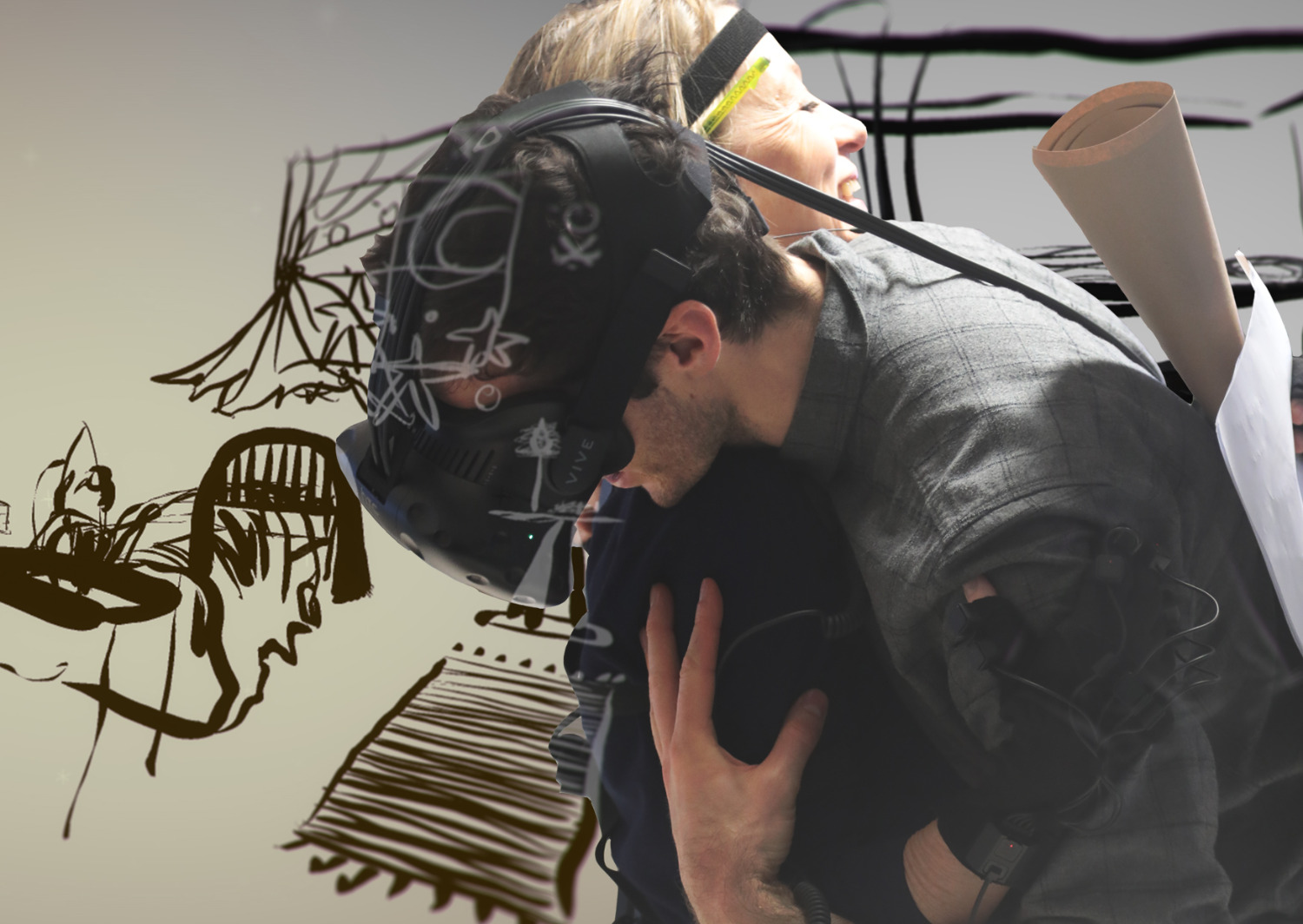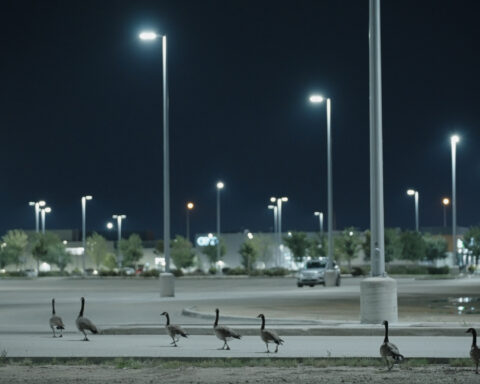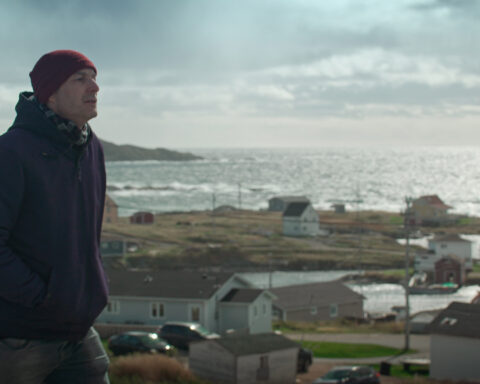The National Film Board (NFB) showcased yet another of its multimedia projects at New York’s influential Tribeca Film Festival this spring. Draw Me Close, a still-in-production long-form virtual reality (VR) experience, follows on previous festival successes such as Stan Douglas’ interactive installation Circa 1948 (2014) and Brett Gaylor’s digital doc Do Not Track (2015). However, the Board’s 20-minute section of Draw Me Close demonstrates just how far VR non-fiction storytelling has progressed in an astonishingly short time. [The completed Draw Me Close appears at the Venice Film Festival.]
Created by Canadian Governor General’s Award-winning playwright Jordan Tannahill, Draw Me Close is the first of several VR prototypes to be built in collaboration with England’s National Theatre (NT), Britain’s exemplar in verbatim or documentary theatre. Three others are currently in development, including Once A Man Twice a Child by Headlong (U.K.) creative associate Amy Hodge.
Based on Tannahill’s memories of his dying mother, Draw Me Close is a blended VR/live performance experience. It drops the VURP (Viewer, User, Reader, Participant) into a primitively drawn black-and-white world to interact with Tannahill’s similarly linedrawn mother. However, there’s a twist: After a while, a real actor actually touches the VURP and guides them to a real bed to lie down. Despite one’s brain being fully aware this is mostly simulated, it is difficult for the VURP to resist playing the poignant role they’ve been given in this brief narrative.
Draw Me Close’s NFB co-producer David Oppenheim explains: “The large discussion in VR and interactive storytelling now is between local agency and global agency. Global agency is the ability of the user to impact the larger narrative to determine how things are told, whereas local agency is about taking action in a scene or a smaller aspect that doesn’t change the narrative. Draw Me Close is scripted, though there is room for user agency or interaction. The actor delivers lines. It shapes the user’s experience of the narrative.”
During the last eight years, the National Film Board has become a major player in the emerging genre of immersive and interactive documentaries—projects meant to be experienced rather than simply “viewed.”
These non-traditional NFB projects include live performance, installation and web-based interactive non-fiction stories, apps and games, some specifically created for mobile devices like iPhones and iPads. Many are a blend of several media platforms, modes of distribution and narrative strategies. Since 2015, the NFB has begun producing projects for virtual reality and augmented reality (AR). Doc enthusiasts needn’t be concerned: Linear film documentaries and animation still represent about 75% of the NFB’s annual budget.
The NFB’s interactive work has garnered many awards and is frequently presented in museums and film festivals throughout the world. In February, during the Museum of Modern Art’s prestigious annual Doc Fortnight, an entire evening of programming was devoted to the NFB’s interactive projects. 11 of its titles are included in IDFA’s (International Documentary Festival Amsterdam) 94 most influential interactive documentaries to date.
For most of its nearly 80 years, the NFB has been a media trailblazer, seemingly always on the vanguard of narrative categories and film technologies. It’s credited as the birthplace of cinema verité—direct cinema—as well as contributing to the development of IMAX, computer animation and 3D film.
Yet, there was a time in the recent past when the NFB’s fabled legacy might have looked like it was headed for the dustbin of history.
In the 1990s, the NFB, like many other government-subsidised enterprises, discovered it was not as nimble as its commercial media counterparts. The NFB was among many public institutions broadsided by the lightning-paced changes ushered in by the World Wide Web and all the new communication technologies that quickly followed.
By the early 21st century, the NFB and other similar institutions around the world were at a tricky juncture. Like its institutional peers, the NFB was a grand old lady with a really colourful past, dependent on governmental funding and public trust. Under pressure to remain relevant in a media culture that was constantly changing, the NFB had to choose how it was going to embrace the future—and do it decisively.
It wasn’t until autumn of 2008 that the NFB began what now seems in retrospect an obvious, yet momentous new agenda. Cindy Witten, then head of English-language programming, hired two Vancouver-based digital producers on temporary contracts: Rob McLaughlin and Loc Dao. They were assigned to explore the creation of projects specifically for the internet—work that would never result in linear films. Soon after, Montreal-based Hugues Sweeney was tasked with developing similar French-language content. With the convergence of these three adventurous producers, in early 2009 the NFB went all in, committing 25% of its annual production budget to a new, wholly digital division..
“Our group started the first digital strategy in 2009,” recalls Dao, who is now the NFB’s chief digital officer. “We came from the CBC, the three of us—radio and public media—and we cut our teeth in what we call interactive 1.0 over at CBC. We got a chance to really do a lot of interesting work there. So when we came to the NFB, we took our knowledge and merged it with the culture of the Board and its history in documentary, animation and longer-form storytelling.“
“In the first wave, the NFB was more involved in catching up than really innovating,” Sweeney remembers. He is now executive producer of the NFB Interactive Studio in Montreal. “The New York Times and CBC moved quite quickly in the 1990s. For the NFB it was to make a giant leap in a very short period of time. Part of its success was that it happened quickly. Inside of 12 months, we already had new pieces out there.”
Along with establishing a department uniquely devoted to the creation of digital content, in January 2009 the NFB also launched its online “Screening Room” at NFB.ca. Suddenly the NFB had a distribution platform for its vast catalog, plus an evergreen home for much of this new, non-traditional work. It also now had a gateway directly to audiences not only in Canada, but all over the world.
Rob McLaughlin, who is currently executive producer for the NFB Digital Studio in Vancouver, recalls: “The distribution piece was really important. To commit to making those films accessible and then having early wins reinforced the notion that there is opportunity around thinking about distribution, audiences and the public differently. The streaming site at the Film Board was pre-Netflix, pre-all the other attempts that have come and gone by the cable companies. It was a smart move to get that done.”
The early interactive documentaries produced by the digital studio were simple, chamber pieces, reminiscent of formats that pre-dated movies; content created that could easily be accessed and experienced online.
“We tackled flat screen or 2D screen content at first. So we created new forms like the interactive photo essay,” Dao says. “The NFB has a rich heritage of photography, so we built on that idea and our experience from the media world and created many interactive photo essays. From there, we evolved into the interactive documentary. We created documentaries that existed online and in apps that you would have some interaction with. We were always story-first, goal-oriented, impact-oriented. We wanted our projects to have emotion, to be relevant [to] our audiences.”
Among the first interactive photo essays to be released was Alicia Smith’s Please Call, Very Sentimental (2009). By clicking on any one of several old photographs displayed on the screen, an actual Craigslist ad for a lost iPhone is revealed. Using a basic point-andclick interface, this documentary gently persuades viewers to explore their own emotional attachment to collected memories.
In The Test Tube (2010), viewers are invited to answer the question “What would you do with an extra minute?” Real-time viewer responses appear visually on the screen as well as slide data from Twitter, while a filmed David Suzuki talks about the planet’s impending collapse from human over-growth and consumption. This interactive work has been accessed online more than 200,000 times. The most frequent answer from viewers of what they would do with an extra minute: sleep.
Much of NFB’s interactive and immersive work, like many of its documentary films, seek to give voice to modern social issues: subjects that reflect Canadian experience and resonate in Canada, though some topics have a universal appeal. Katerina Cizek’s internationally award-winning Highrise (2009) was conceived as an online interactive exploration of vertical living in public housing. It has since had several other media manifestations including a series of short films co-produced with and for the New York Times website.
Public installations are also part of the NFB’s digital initiative. Thibaut Duverneix, Guillaume Braun, Bruno Choinière and Philippe Lambert’s A Journal of Insomnia (2013), whose subject was literally sleeplessness, began as a website, and later was staged in art galleries and at film festivals. Moment Factory’s Megaphone (2013) was conceived as an installation. The NFB placed a megaphone in an outdoor urban space, inviting people to freely express themselves. As each spoke, their words were simultaneously “visualised” and projected on a building directly behind, amplifying their own personal ideas, complaints and random thoughts to a public audience.
“We shifted towards this idea that a concept or a story was the heart of a project, but a project could have many spokes on a wheel.” Dao notes. “Although online interactive projects and apps were where we would reach the largest audience for our work, we also started doing live performances and interactive installations, first at festivals and later on in public spaces, mainly in Montreal and Vancouver and Toronto. And that rounded out our growth. From there, we started really growing more into new forms of storytelling for new audiences. We’ve followed the NFB’s rich heritage in being an incubator for ideas of story and technology. One of our mantras throughout the years has been the creative application of technology to story and form.”
By tapping into a world where audiences are eager to simultaneously consume and participate, the NFB has found an extremely fertile sector in which to play. Interactive projects created with the digital studio reached over 7.5 million people just in its first seven years.
“We rooted our production in the tradition of the NFB which is one-off,” Sweeney points out. “We don’t really make series. We don’t really make formats. The difficulty with that is that we didn’t just rebuild the content; we rebuilt the medium and the media. We gave ourselves that level of difficulty, which also leads us to intriguing places and things to do.
“We’re trying to develop stories made for social media, whatever it may be. Just think about people discovering more and more and more and consuming their content on Facebook and Instagram. How does it happen there instead of elsewhere? So I think our challenge is: How do we bring people into these experiences?”
One way is simply to create lots and make them as widely available as possible.
To date, the Digital Studio has released more than 50 interactive works, with many more already in the pipeline. Interactive documentaries vary wildly in length and complexity and so do the budgets, which can range from $20K to $300K.
The audience, especially for VR content, is expanding rapidly as the platform’s viewing options grow. Advanced VR-enabled web browser updates are expected from Google Chrome, Mozilla Firefox and Microsoft this year. The recent introduction of mobile-enabled consumer-market goggles like Samsung Gear VR, Google Cardboard and Daydream have also made VR infinitely more accessible and attractive to a wider audience.
Another way to bring more people into these experiences is to make emerging technologies—the mechanism for creating these experiences—available to a wider group of “makers.” The NFB, in its role as a public producer is not only uniquely positioned to do this; it’s one of the reasons the NFB exists. Michelle Van Beusekom, executive director of English programming and production, refers to it as “Our public sector advantage. We’re not being driven by a commercial mandate; it’s a cultural mandate, a social mandate.”
Open Immersion: A Virtual Reality Creative Doc Lab was a direct expression of this, the NFB’s raison d’etre. In October 2016, the NFB along with Just Films/Ford Foundation and the Canadian Film Centre’s Media Lab brought six Indigenous Canadian artists and six Southern States-based Americans to Toronto to explore non-fiction VR storytelling during a nine-day residency.
“I think Open Immersion was an acknowledgement of the fact that these new technologies are often available in the first instance to a more privileged group of creators,” Van Beusekom explains. “We wanted to come together with two different partners in an effort to make this technology available to creators who might not have as easy access.
“It was also a way to interrogate those claims about VR and empathy. VR: the ultimate empathy machine. VR is like any technology, any experience; it’s not neutral but it gives us the illusion of being in a world. But what kind of world is being created? And what kind of story? One of the potentially dangerous things about VR is that it does feel so real, but it’s not neutral; it’s constructed. We need to acknowledge that and then that can become a really interesting creative terrain to explore. What are VR projects trying to tell us, intentionally or unintentionally, about the world, the values we think are important, how we experience the world? Those are some of the goals that inspired Open Immersion.”
The NFB’s digital division has been especially successful at developing new business partnerships, not only with other media producers and distributors—like France’s Arte, the U.K’s National Theatre and England’s The Guardian newspaper—but also with technology companies like Google, Microsoft, HTC and Facebook’s Oculus. These partnerships have not only shored up the NFB’s annual budget; they also create extraordinary opportunities for content experimentation, influence on technology development and new avenues for audience growth.
As a genre for artistic expression, digital interactive and immersive non-fiction documentary is not even two decades old. Yet the human impulse to express one’s own point of view is as old as art, as old as humanity itself.
“I think that if you want to think about what interactive brings to the documentary tradition, for me it’s really about bringing the audience point of view to the interpretation of a subject,” Sweeney notes. “Traditionally, it’s been the point of view of one person or a very small group of people, but what happens when you have the capacity to have the people who are viewing be part of the exercise or the process? It changes the dynamic of how you look at a particular subject, having it personalised, having people contribute. It’s the way it connects you personally to the stories of the people you will see in that place. With a simple line of code, it completely changes perspective.”













